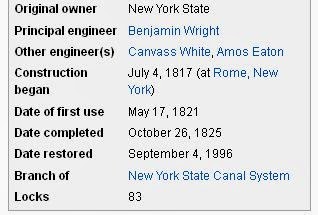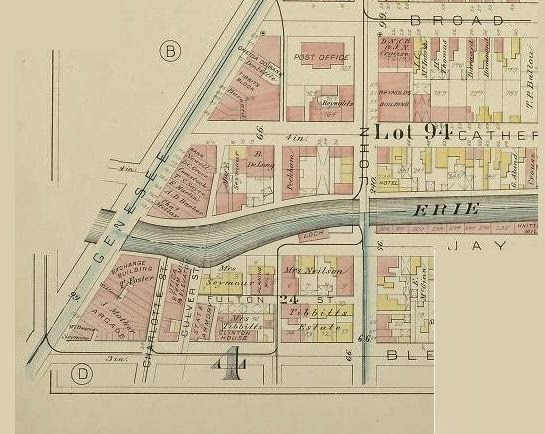OK, it's probably time to come down. In the distance left, the spires of St. John's Church. No, I don't call it "Old St. Johns." It's only 70 years older than the day I was baptized there and that's not much older than it was all of my life. My Great Great Grandfather Michael, fresh from the ould sod was married there in 1826 (I think in an earlier structure before the fire) .
My notes say these buildings were on the corner of Whitesboro and Genesee Streets. It must be quite old, from the first half of the 19th century.
The Averell House stood by to serve you lunch or dinner. In the grey tone bird's eye view of Bagg's Square and Utica, Averell's was down next to the railroad tracks on the west side of the square.
1843
The Utica City National Bank must have really grabbed the attention of anyone coming into the city.
My eyes are tired tonight. A volunteer to interpret the writing at the bottom of the card would be appreciated.
Above, this photo of the City National Bank Building was color-enhanced by our friend Kit from the "Clipper's Busy Corner" proboards forum. (clipper220.proboards.com) Thanks, Kit!
 |
| Today | | | | | | |
Fiona and I believe the Roberts Hardware Store was in this area of lower Genesee Street.
I assume this ad was for the the Roberts Hardware/Sports store.
Below, the John Roberts Store, "Flanel, Blankets and Wash goods."
An ad in the Herald Dispatch for the John Roberts dry goods store.
 Thanks to Fiona, here is a photo of The Leader Store's building just below the Hump Bridge over the Canal on Genesee Street. The Leader Store was evidently a retail chain or organization of stores. Perhaps that is what is meant by the term "cooperative store" in the Retail publication also shown below.
Thanks to Fiona, here is a photo of The Leader Store's building just below the Hump Bridge over the Canal on Genesee Street. The Leader Store was evidently a retail chain or organization of stores. Perhaps that is what is meant by the term "cooperative store" in the Retail publication also shown below.
Here's a shot looking North from the Erie Canal Bridge. We're looking in the opposite direction of Hans' view in the last post. My notations on the 1920's era card are from a post I made elsewhere as I tried to remember what the block was like when I was in high school in the late 1950s. They're self explanatory, except for the green rectangle that outlines the building in which I held an after-school job..
This photo is from the late 1940's. From what I remember of it, the building was made to look like a giant ice sculpture from all the water poured on it by firemen. As kids we called it the Allen's Bakery Fire which was the business on the first floor and I think the part of the building where the fire started. The event goes by other names and perhaps you know and would comment. Go ahead and comment on anything mentioned here. You can do so on the FB post that pointed you here.
A nice view of the Mann Building on the corner of Genesee and Broad Streets.
Above: If I were standing here in the middle of Genesee Street looking east out Catherine in the 1950's, the First National Bank on the left would have been replaced by Mike Cuda's Mobil gas station. And part way down Catherine on the right was the loading dock and back of the Observer Dispatch building. Part way down on the left was the back of the Post Office.
Come ahead almost a half century and I believe that's Bernie Phillipson's Army-Navy (don't ask whose) Store on Genesee and ... was it Liberty Street? I could use some help. I remember it well, just not exactly where it was.
Next time we'll post photos and postcards of Side Trips away from Genesee St., east and West along two major side streets. And then we'll continue our way up to the Erie Canal and on to the Busy Corner.
Comments welcome! Rather than make them here, it would be best (and a heck of a lot easier) to comment on the FaceBook post that sent you here.


































 I
I 












































